Last Updated on October 30, 2024 by Owen McGab Enaohwo

In many organizations, succession planning isn’t a priority. Research reveals that only 35% of organizations have an effective succession planning process. The process is only considered urgent when a company faces the departure of a key executive or employee. But at this point, it’s usually too late for a seamless transition.
If you’d like your business to continue to run smoothly after key employees leave, retire, or pass away, succession planning is a must. It’s also a good way to prepare a company to promote and advance all employees—not just managers or key executives.
SweetProcess can help you build an effective succession plan by streamlining the process. Ensure you have the right people in the right jobs today and in the future. Sign up for a 14-day free trial without a credit card to see how it works.
Table of Contents
What Does Succession Planning Mean?
Why Is Succession Planning Important for a Business?
How to Create a Good Succession Plan: A Step-by-Step Guide
How to Create a Succession Plan for Your Business Using SweetProcess
9 Best Practices for Creating an Efficient Succession Plan
5 Succession Planning Examples From Which to Learn
Challenges of Succession Planning and How to Overcome Them
How Succession Planning Relates to Other Similar Terms
Start Your Company’s Succession Plan With SweetProcess
What Does Succession Planning Mean?

Succession planning is the process of developing potential leaders within an organization who can take up a leadership position when it becomes vacant. It involves assessing staffing needs and developing long-term goals and strategies to manage those gaps. Effective succession planning ensures internal candidates fill key organizational roles if the post holders transition, leave, retire, or pass away. It is important for all companies, large or small.
The succession planning process creates a talent pipeline of successors, ensuring the organization runs smoothly when inevitable staff changes occur. It protects large and small businesses against staffing disruptions or sudden job vacancies. As demand for skilled professionals increases, succession planning helps companies proactively identify, nurture, and retain high-value employees.
Organizations with a robust internal talent pipeline ensure seamless leadership transition and foster a culture of growth and professional development. They easily plan for the unexpected and seamlessly replace top talent. A good succession plan equips employees with the skills and competencies needed in their future roles.
A customized succession plan promotes employee growth and ensures successors make the right impact. When key employees leave, you can use objective metrics like engagement scores and performance reviews to fill open positions.
Here’s a short scenario to help you understand succession planning better:
A CEO in a company without an effective succession plan suddenly falls seriously ill. The board of directors rushes to find a replacement. Chaos ensues. As the key role remains vacant, the company’s stock plummets and investors panic. Unsure of the future, employees start looking for other jobs.
Projects stall, and clients grow frustrated as time passes without a clear successor. Employee morale goes down, and talented employees leave. The company’s reputation suffers, and a once-thriving organization now faces an uncertain fate. A well-prepared succession plan can ensure a smooth transition when leadership changes.
SweetProcess supports succession planning by helping you identify high-value employees and streamline their learning process.
Why Is Succession Planning Important for a Business?

A succession plan helps companies develop an action plan for high-performing individuals to fill key positions. The right people are in the right jobs at the right time—now and in the future. Organizations are ready when talent needs arise, can easily identify talent risk, and have guided talent development. Here are the top benefits of succession planning:
Creates a Structure for Training and Development
Once potential successors for key positions are identified, preparing the succession candidates starts. A strategic plan for the employee’s professional development is created. Training and development may include job shadowing, mentoring, coaching, and increased responsibilities. The potential candidate may even go back to school to acquire professional certification. A succession plan helps organizations identify and develop potential successors early. They have ample time to acquire the skills needed for their next roles.
Reduces Talent Recruitment and Hiring Costs
Organizations are always looking to reduce costs; a succession plan can help. Since critical roles are filled internally and not externally, recruitment costs go down. The company saves money it would have spent on external recruiting. Staffing companies charge a lot of money to help organizations hire appropriate candidates. There are also costs related to employee onboarding. These can be avoided with a succession plan.
Helps the Company Plan for the Long Term
In every marketplace, the businesses that survive and thrive expect change and prepare for it. When your company is prepared for an uncertain future, success is inevitable. Include succession planning in your company’s growth plans to ensure retiring or resigning employees hand off their hard-earned knowledge and experience before they leave.
A succession plan ensures a company continuously grows as it identifies and prepares for vulnerabilities in every business area. It sets realistic growth goals and efficiency plans for future talent needs that arise from that growth.
Identifies Your Most Qualified Future Leaders
Here’s how a formal succession plan works:
- An organization identifies the most critical positions for the company’s future success.
- Potential candidates with the skills to take on those critical jobs are identified.
- They undergo training to ensure they can take on those roles when needed.
These crucial steps help leadership better understand potential vulnerabilities and cross-train key employees. If no candidates are internally available to fill the positions, an external search is launched early.
When less-experienced employees know they can be considered for advancement, they become more motivated. A succession plan becomes an incredible employee retention tool for employees who want to advance their careers.
Highlights the Specific Skills Gaps in a Company
Succession planning can help companies identify skill gaps in their management teams. They can identify the skills needed for future leadership roles and develop a robust talent pipeline to address the gaps proactively. A succession plan highlights areas for business growth, enabling an organization to develop critical skill sets that allow it to thrive now and in the future.
Reduces Organizational Risk
Many companies focus on daily operations and don’t prioritize succession planning. They forget that competitors could poach high-performing employees, or key executives may fall sick, leave, or retire. These scenarios can make a company vulnerable. Succession planning protects a company for the long term. Start working on your succession plan to reduce organizational risk.
Boosts Engagement and Morale
A succession plan can tremendously boost employee engagement and morale. It highlights growth possibilities and encourages employees to upskill. When employees have an optimistic view of their future in an organization, they’re more inclined to stay for the long haul.
Succession planning boosts employee engagement by creating a platform to voice their needs and opinions. They feel recognized and appreciated by the organization and give their best. The plan creates a healthy environment.
Maintains the Brand Identity and Establishes Your Company’s Legacy
We’ve often read stories of new CEOs who get hired with pomp only to fail quickly. Bad hires don’t just damage a company’s reputation—they damage its long-term growth. A CEO who gets promoted from within the company understands the company’s fundamental values, mission, and customer needs. They help the organization focus on these.
A succession planning process helps your company avoid future chaos. An internal successor is identified and prepared in advance so the company is always led by people who share its values and deeply understand its mission, customers, and employees.
How to Create a Good Succession Plan: A Step-by-Step Guide

Step 1: Understand Your Current and Future Business Needs
A succession plan’s assessment phase involves identifying skills essential to your company’s success. This could be certifications or other soft skills like customer relations. Identify the significant business changes that may happen in the next one to five years and the critical skills and qualifications needed to support business continuity.
Step 2: Define Your Timeline, Goals, and Key Performance Indicators (KPIs)
Define the timeline, goals, and key performance indicators when developing a succession plan. Here are the top KPIs to measure in a succession management plan:
- Scope: Which critical roles require successors? Your succession program should cover all non-entry-level roles.
- Completeness: Are plans set up for all critical roles?
- Readiness: Evaluate each successor’s readiness to take on the role.
- Bench Strength: What’s the organization’s ability to immediately fill critical positions with a talented internal candidate?
- Diversity: Does your succession management plan leverage the available talent in the organization? Does it overlook some potential successors because they have different backgrounds and experiences?
Step 3: Assess Your Current Workforce Planning to Identify Critical and Vulnerable Positions
Evaluate key positions that are critical to the organization’s success. Roles that are critical to the organization’s operations include senior management and departmental heads. Once key positions have been identified, determine the institutional knowledge and skills required for each role.
Step 4: Identify and Assess Potential Successors
Determine the candidates with the necessary skills and experience to fill the role—or those who can be trained to take on the roles. When identifying successors, consider their potential for growth and development. Assess their leadership skills, how they face challenges, and their willingness to learn and adapt.
Step 5: Identify Skill Gaps and Competency
Tools like 360-degree feedback, performance evaluations, and skills assessments can provide valuable insights into your workforce’s strengths and development needs. This creates a foundation for identifying skill gaps and planning development initiatives.
Step 6: Craft an Action Plan to Develop Potential Successors
Create a customized succession plan for each potential successor. Outline their current and desired state, learning and development requirements, skill gaps and areas for improvement, the timeline and goals, and the KPIs. When creating the plan, involve the individuals, their managers, and important stakeholders to ensure it’s realistic, flexible, and aligns with company goals.
Step 7: Implement the Transition Strategies and Appoint a Successor
Once the critical role becomes vacant, implement the succession plan and support the successor. You can assign a mentor to guide and advise them and provide opportunities for exposure, experience, and feedback.
Step 8: Review and Monitor the Succession Plan
Evaluate the effectiveness of your succession plan and the candidate’s progress and performance. Make adjustments regularly to ensure that the succession plans stay relevant and effective. Also, communicate with the successors and their managers and reward their achievements.
Step 9: Document the Transition
It’s important to document the transition to inform future succession processes. Include the following details:
- The demands of the position
- The steps followed to ensure a smooth handover
- Issues that arose during the handover
- Areas to be addressed
A process documentation tool like SweetProcess can help you optimize your succession planning strategy for future training and development.
How to Create a Succession Plan for Your Business Using SweetProcess
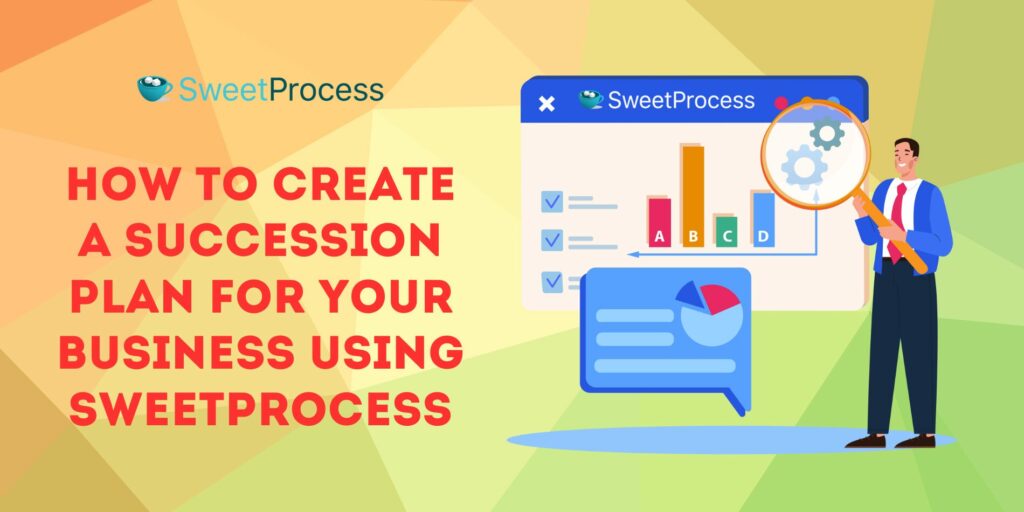
Document Repetitive Tasks in One Place
To document a repetitive task in SweetProcess, create a minimum viable procedure. Create a new procedure and add the titles of each task step. You can use SweetAI to add the titles and fill out the details of each step.
Log in to your SweetProcess account or create a new one. Click on the “Procedures” tab on the main dashboard.

Add the procedure title and the teams you want to be notified. Next, decide whether to write the procedure manually or with SweetAI. SweetAI makes the process very easy.
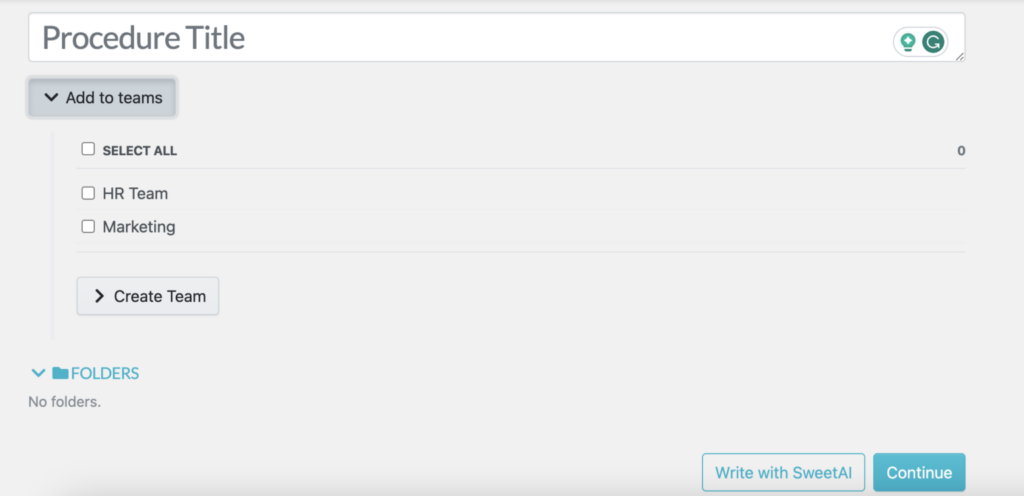
Once you add the title and click on SweetAI, relevant titles and details will be added. SweetProcess automatically creates flowcharts as you document your procedure.
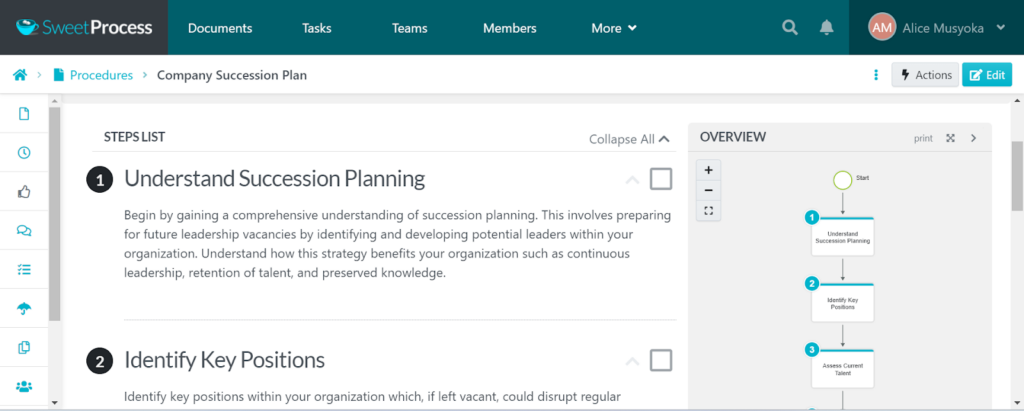
Turn Procedures and Processes Into Actionable Tasks
Assign the succession plan procedure to specific teams that need to review it or complete specific tasks. Once tasks are completed, you’ll receive a notification on your dashboard.
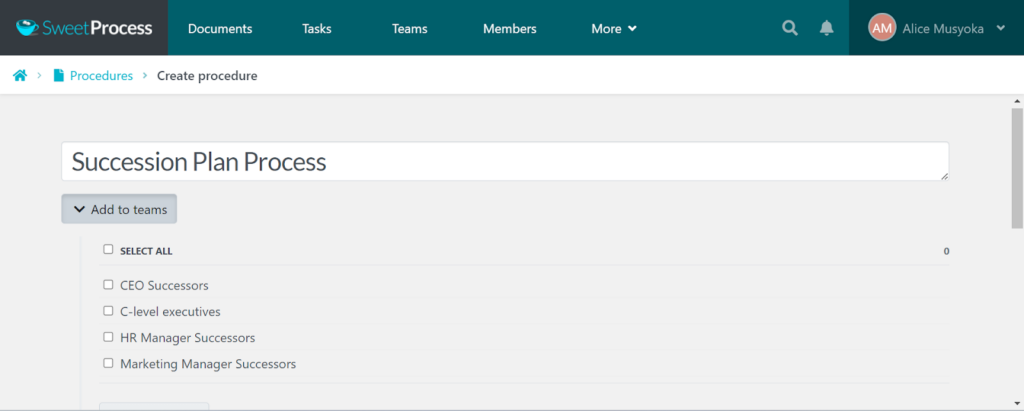
Create Internal Knowledge Bases From the Procedures and Policies
On the dashboard, click “More” and then “Knowledge Bases.”

Click on the “Create Knowledge Base” button, add the title of your knowledge base, and click the “Continue” button. Then, add all relevant information about the succession plan. The knowledge base can be used to train potential successors. Managers and mentors can also refer to it to know what’s expected of them.
Set up Teams and Collaborate With Them in Real Time
You can set up new teams to boost collaboration when creating the succession plan procedure. Collaboration happens in real-time.
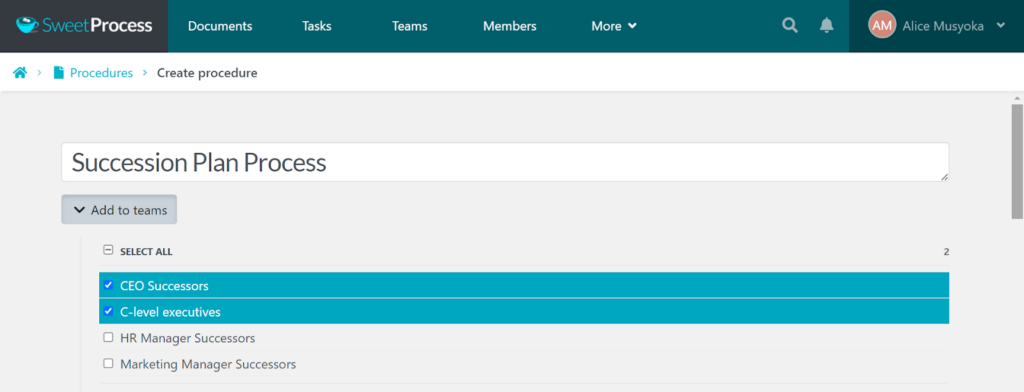
SweetProcess integrates with third-party platforms like Google Drive, Slack, Quickbooks, and Zapier, enhancing collaboration. Features like document sharing allow teams to collaborate on documents and projects.
9 Succession Best Practices for Creating an Efficient Succession Plan

Plan for the Long Term
To create an effective succession plan, think long-term. Focus on longer-term succession planning; forecast your workforce needs for the next five, 10, or 15 years. Clearly define the roles to fill, their requirements, and what’s needed for continuous business success. Identify competencies, skills, and other required criteria for potential successors. This will help you to consider the strongest candidates.
Ensure Structured Development
Your succession planning process should be structured and documented to meet current and future needs. Use a tool like SweetProcess to outline how potential successors are identified, developed, and trained for a future role. A structured plan outlines succession criteria, helps with candidate assessment, and defines the requirements for succession readiness. It supports a smooth transition of roles.
Integrate Succession Planning Best Practices With Performance Management
Performance management is key in succession planning because it facilitates the identification of high-potential employees. These candidates have the skills, experience, and qualities to excel in leadership roles. By regularly conducting employee evaluations and having clear performance metrics, management can identify individuals with strong potential for growth and promotion. The organization will always have qualified candidates to fill critical positions.
Be Proactive With a Succession Plan
When you have a proactive succession strategy, you plan. You don’t wait until a senior manager announces their departure—you dedicate time and resources to developing and training potential successors. You prepare for staff changes now and have a plan when they eventually exit.
Step up Professional Development Efforts
Succession planning efforts are not a one-off event but a constantly evolving process. Review your succession plan regularly to ensure timely talent assessment and role requirements are current. Provide development opportunities—workshops, training, education, and resources—to prepare potential successors for their future roles. Focus on the skills and leadership qualities required for key positions to bridge the gap between current capabilities and future needs.
Communicate Clearly
To manage expectations and ensure transparency, clearly communicate the succession planning process and its outcomes. Every employee should be able to access the information on how potential successors are identified, developed, and selected. This promotes a positive and inclusive work culture. Make sure everyone understands the role they play in the organization’s success.
Consult Your Leaders
Involve senior leaders to boost the credibility of the succession planning process. When top executives help identify and groom future leaders, everyone knows that succession planning is a top priority. Involve top management in succession planning best practices meetings, decision-making, and mentoring potential successors.
Measure Outcomes, Not the Process
To know the effectiveness of succession planning, you must be able to measure and evaluate its success. It’s essential to track if goals are met and objectives are aligned. Measure outcomes such as:
- The internal promotion rate
- Time taken to fill key positions
- Numbers of successors per critical position
- Diversity and inclusion benchmarks
- Retention of high-potential employees
- Productivity and performance of successors
Regularly Evaluate and Update Your Succession Plan
Update your succession planning program regularly to ensure it achieves its intended goals. Assess the impact of leadership development initiatives, monitor the progress of potential successors, and get feedback from key stakeholders. Based on the measurable goals you’ve set, evaluate your results and refine the program as needed.
5 Succession Planning Examples From Which to Learn

Example 1: Apple
Steve Jobs was a visionary leader who built Apple into what it is today. But when he fell sick, he knew he had to choose a capable successor for the company’s continued success. He identified his successor, Tim Cook, and prepared him for the role.
Cook was Apple’s chief operating officer before he took the helm. He was a top choice because of his experience and understanding of Apple’s culture and values. He also had a deep understanding of the technology landscape. Cook managed the company effectively whenever Jobs had to take sick leave.
Apple has thrived under Cook’s leadership. He has increased the company’s profitability by focusing on diversity and sustainability while sticking to Jobs’s core principles. Jobs’s succession plan made for a seamless transition, resulting in Apple’s dominance in the tech industry.
Example 2: Microsoft
In 2014, Microsoft CEO Steve Ballmer announced his retirement. The board of directors selected Satya Nadella, someone with a track record of long-term success in different leadership roles. Nadella helped transform Microsoft into a cloud-first company, expanding the company’s cloud services and leveraging artificial intelligence.
Under Nadella, Microsoft has undergone a cultural shift, focusing on innovation, collaboration, and its customers. It has formed strategic planning partnerships and embraced open-source technologies to remain a leader in the tech industry.
Nadella’s success shows the effectiveness of succession planning. By choosing a leader aligned with Microsoft’s vision, the company seamlessly transitioned into a new growth phase and relevance for future success.
Example 3: Unilever
Unilever, a global consumer goods company, is a great case study in succession planning. The company has continually adapted its leadership to fit evolving market trends. The transition from Alan Jope to Hein Schumacher was marked by a seamless continuation of Unilever’s sustainability agenda. Schumacher, just like Jope, is committed to Unilever’s values: sustainability, innovation, and continually adapting to a dynamic business landscape.
Unilever is known for nurturing leaders who drive sustainable business practices and align the organization with changing consumer and stakeholder expectations. Successors possess the necessary experience and skills and have a deep knowledge of the company’s values and commitment to sustainability and social responsibility.
Unilever’s succession planning process is effective because it doesn’t just focus on filling leadership roles but strategically positioning potential successors to shape the company’s future trajectory. Innovation, sustainability, and global awareness are integrated into the leadership pipeline, ensuring a streamlined and impactful transition that resonates with its global audience.
Example 4: Amazon
Amazon’s unique approach to leadership development and penchant for risk-taking ensured a smooth transition from Jeff Bezos to Andy Jassy. Bezos was always willing to venture into new territories, and this continues under Jassy’s leadership. Jassy is equally willing to innovate and explore uncharted territories.
Amazon grooms leaders who aren’t afraid to disrupt norms. Potential successors are committed to customer-centricity, innovation, and calculated experimentation. The company shows us that successful succession planning in a dynamic business environment requires daring leaders who embrace risk and anticipate industry shifts to ensure continued growth and market dominance.
Amazon’s succession planning teaches us that it’s vital to integrate innovation and calculated risk-taking into the process. To thrive in an era of relentless change, you must groom leaders with an unwavering commitment to core values and a willingness to adapt.
Example 5: IBM
Over the years, IBM has adapted its succession planning strategies to fit the ever-evolving tech landscape. The transition from Ginni Rometty to Arvind Krishna illustrates the company’s ability to identify and nurture leaders who can navigate the challenges of technological disruption. Technological innovation is a key part of IBM’s succession planning approach. Successors deeply understand technology trends and their impact on the industry, ensuring IBM remains at the forefront of technology transformation.
The transition from Rometty to Krishna reveals IBM’s dedication to diversity in leadership. Rometty was the company’s first female CEO, while Krishna is of Indian descent. IBM’s commitment to fostering an inclusive leadership pipeline enhances its ability to approach diverse industry challenges.
IBM aligns succession planning with the industry’s unique demands. Successors drive innovation, anticipate disruptions, and adapt quickly. Its dynamic approach positions it to succeed in an era of rapid technological change.
Challenges of Succession Planning and How to Overcome Them

Choosing the Wrong Successor
Choosing the wrong candidate can significantly hamper succession. This may happen due to disengagement from the succession planning process or a leader’s self-protective instincts. Putting the wrong person in a principal role only hurts the company in the long term. When choosing a successor, look for a candidate with real-world experience. An internal successor is more likely to be successful than an external candidate.
Not Tracking Relevant Succession Planning Metrics
Most organizations create a succession plan but fail to track important metrics. Tracking succession planning metrics helps you know if your plan is effective, what’s going well, and what’s not. Measure the outcomes of the succession plan rather than the process itself. These include:
- Bench strength: The organization’s ability to fill critical positions internally.
- The number of high-potential employees identified for each critical role: Each critical role should have at least two potential successors.
- Percentage of critical positions filled internally: This helps you know your organization’s ability to develop talent internally.
Not Having an Inclusive Succession Plan
A past research study revealed that companies with ethnically and culturally diverse executives are more profitable than their competitors. Gender diversity also makes a company more profitable. To grow your bottom line, recognize and overcome bias during the succession planning process. Use different data sources to identify suitable successors, such as real-time information on workforce skills and competencies and historical succession decisions. This will help you build a diverse talent pipeline.
Not Following Through on Development Plans
If potential successors and their managers are too busy to follow the development plans, chaos will ensue when it’s time for succession. Motivate potential successors to learn and grow continuously. Keep development on track with job rotation and special assignments. Set milestones for them and ensure they are achieved. Combine learning with real-life scenarios to help the employees solve organizational issues. They’ll be motivated to follow the development plan when they see tangible outcomes from their efforts.
Failing to Update the Succession Plan Regularly
Succession planning is not a one-off event; an effective succession plan is regularly updated. Set regular intervals for evaluating and updating the succession plan based on organizational changes. Changes that trigger an update may include business restructuring, employee turnover, the addition of a new department, or a senior manager leaving unexpectedly. Even if there aren’t any major organizational changes, review your succession plan regularly.
Not Managing Employee Morale
It’s important to manage employee morale during your succession planning process. Some employees may be demotivated because they’re not included in the plan, while some potential successors may not want more responsibilities with an uncertain promise of promotion. Communicate clearly how the process works: the criteria for choosing potential successors, the development expectations, and promotion timelines. Employees will understand why some are added to the plan while some are not.
Underestimating the Changing Nature of Work
To create a succession plan that works, anticipate future needs. Take time to reflect on the future of the role. How will it be affected by technology changes, organizational changes, or the broader industry? Some jobs may be phased out by technology in the coming years, so ensure you’re training successors for a role that will still exist when they are ready. They should acquire skills that will be essential in the future.
How Succession Planning Relates to Other Similar Terms

Succession Planning vs. Replacement Planning
Succession planning focuses on developing talent to fill vacant job positions, while replacement planning is about identifying immediate understudies. Succession planning ensures a constant supply of potential leaders for the organization, while replacement planning helps identify individuals who can step into vacant positions quickly.
Succession Planning vs. Talent Management
Succession planning helps a company plan for staffing changes and seamless transitions. On the other hand, talent management helps organizations retain and develop the top talent they need to succeed.
Succession Plan vs. Growth Plan
A growth plan prepares your organization for future growth. It focuses on the company, not the employees or how they will grow with the organization. A succession plan focuses on training employees that will drive the company’s growth. You can’t have a growth plan without a succession plan.
Start Your Company’s Succession Plan With SweetProcess
Make the most of technology to streamline your succession planning process. Use SweetProcess to track your progress and maintain an up-to-date succession plan. You can create policies for assessing talent and monitoring development progress.
Our platform also lets you update succession plans in real time. Additionally, you can create quizzes to get feedback from potential successors, mentors, and trainers. SweetProcess allows quick adjustments to succession plans based on current needs and future goals.
Create a succession plan that works with SweetProcess. Sign up for the 14-day free trial now and get started.

